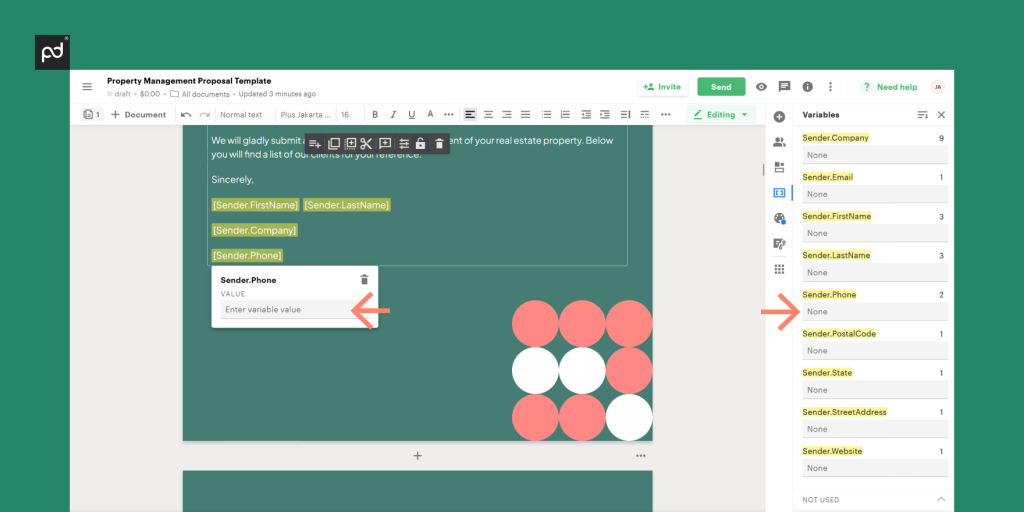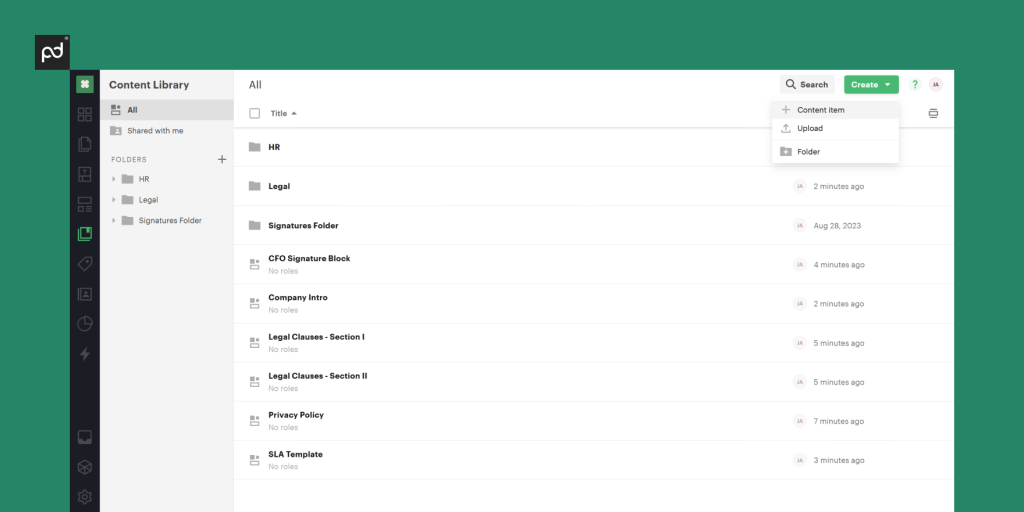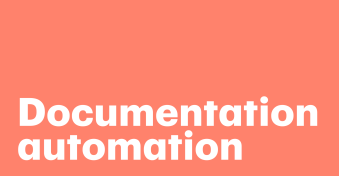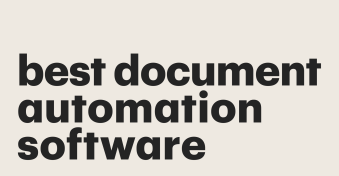In this article, we’ll take a closer look at why and how you might want to automate your documents and what tools you’ll need to get started.
Key takeaways
- Automating legal documents largely revolves around using software to create templates that target common client needs.
- An automation process can rely on boilerplate language, research, and citation (where necessary), but it should also include personalization in the form of variables and customizable text snippets.
- Automation in the legal field isn’t intended to replace lawyers, but it should free legal experts from redundant tasks and allow them to apply their expertise in more specialized ways.
Why (and when) to start automating legal documents
Big or small, most legal firms are busy.
This could be due to an unprecedented workload, a shortage of legal professionals, or a drive to expand the organization into a new legal field.
At the same time, firms can ease many of these organizational pressures by using automation to streamline their document creation workflows.
While many scenarios and legal services require some level of personalization, clients need legal documentation designed around existing law.
Once a firm has completed the research to build a document, creating a second document of similar legal status becomes far less time-consuming.
Automating legal documents helps to minimize the amount of time that legal experts need to spend creating specialized documentation.
For example, let’s assume that a legal firm has created a nondisclosure agreement for a company that is governed under the laws of New York state.
After the legal research is done and the NDA is created, many of the same legalities used to build that document would also apply if another client made a similar request.
Firms could leverage automation technology to create a template from the original document by removing unique client information and replacing those details with insertable variables.
This approach allows the unique information (company / client names, addresses, industry information, etc.) to be exchanged on the fly.
From there, the firm could create a client intake form based around those variables.
Clients fill out the form, the legal team adds the information to the template (replacing the variables) and the contract is automatically built in a matter of seconds.
Of course, the system isn’t foolproof.
Legal teams still need to verify that the legal language of the contract is applicable to the client and a given practice area.
Expanding on our current example, if the laws around NDAs are different for brick-and-mortar retailers and construction companies, some additional customization may still be required.
However, in doing so, the firm could simply create a second document template that is applicable to that unique set of circumstances.
The power of document automation comes from its ability to allow a legal practice to reuse its documentation and research to serve clients while still providing a deep level of customization.
Done correctly, a document automation system can increase profitability, reduce human error, and improve the client experience.
And that’s a major win for both the legal industry and the clients they serve.
Has your automation process already started?
If you’re seriously considering document automation, it’s worth taking a moment to review whether your own automation process has already started.
While it’s true that document automation tools can create huge time savings, many firms end up creating an unofficial automation process just to lower costs and keep up with client workloads.
Often, this approach incurs a greater level of organizational risk as new documents are simply copied from previous contracts and edited using word processing tools like Google Docs or Microsoft Word.
While this does reduce the time required for drafting documents, it also increases the risk that critical or confidential information won’t be properly removed from a document during the duplication process.
If you’re seeing signs of unofficial document automation (or if you already know that it’s taking place within your practice), it may be better to embrace this approach by supplying the appropriate legal technology tools rather than relying on lawyers and paralegals to create their own productivity systems.
Types of documents you can automate right now
It might not be obvious at first glance, but many common legal documents that law firms are responsible for creating can be automated using legal document automation software.
A good place to start automating is with documents that meet the following criteria:
1. Highly standardized
Documents that are highly standardized usually carry specific expectations around layout, format, and content.
Any document that adheres to a standardized, widely accepted template, is a great candidate for automation.
2. Offer repeatable processes
Any document that requires a quick input to achieve a specific output is an automation candidate — both for firms and for clients.
For example, if a client needs to create multiple NDAs, they could do that by simply changing the name of the individual who needs to sign the document and leaving all other information the same.
3. Follow the same application of law
For firms, documents that follow the same laws can be automated to serve a wider selection of clients.
If a firm deals primarily with clients in a given niche or geo-centric area, it’s likely that the same legal statutes and regulations will apply across a wide number of clients.
Documents that address these legalities are likely strong candidates for automation.
4. Require minimal informational exchange
Any document that can be created with minimal informational exchange between the firm and the client is a good automation candidate.
Clients can simply fill out forms, and the automation software can fill in the appropriate details, allowing for faster turnaround times and minimal client touchpoints.
5. Are built for purpose
Documents built to perform a specific legal or business function are perfect automation targets.
These documents often have a narrow scope or a single, limited use and may be replicated by both clients and firms.
Especially for firms working in niche areas of practice, creating templates from these documents can vastly expand the firm’s document library while dramatically reducing the time and effort required to meet client requests.
Here’s a closer look at common documents that you can automate right now.
6. NDAs, NCAs, and confidentiality agreements
One of the most straightforward documents that can be automated is a non-disclosure agreement and similar agreements like non-compete agreements or confidentiality agreements.
Each of these documents is built for a specific purpose and offers a high degree of replicability.
In most cases, the business will require most/all employees to sign the agreement, meaning that the document needs to be replicable by default.
With that in mind, a legal team will need to create a confidentiality agreement that the client can then replicate on their own and distribute to their employees.
However, for legal firms working in any location where the legalities of NDAs are the same, it’s possible to create one legal document that is suitable for the majority of clients and simply distribute that upon request.
7. Terms of service agreements
Most terms of service agreements, particularly clickwrap agreements, are excellent automation candidates.
Despite the fact that these documents are often robust and highly technical, the majority of clickwrap agreements use similar language to retain usage rights to the product and protect the company from liability.
Legal firms may need to create complex documents using their preferred document automation solution so that they can add specific phrasing based on client requirements.
However, even considering that level of customization, the automation opportunity remains.
Because TOS agreements often require minimal user interaction and are considered to be part of the company’s standard documentation, legal firms only need to compile boilerplate language, add in the appropriate details, and send the final document to the client.
8. Privacy policies
Similar to terms of service agreements (discussed above), privacy policies fall into a category of clickwrap documents designed to inform customers and shield a company from legal liability.
While these documents will need to be constructed based on a client’s intended use case for customer data, many of the language created for one policy will be replicable across multiple policies.
For example, if a client intended to capture specific types of user data and use that to create anonymized profiles for ad targeting purposes, it’s unlikely that the language used to describe that process will be applicable to only one company or organization.
To automate, firms may need to create a robust backend using document automation tools like a content library that can hold a variety of approved snippets.
Then, figuring out which snippets need to be included in the privacy policy is a matter of client preference.
Have clients fill out a questionnaire regarding their use case for these documents, add in the relevant sections, and compile using an automation platform.
9. Purchase agreements
The automation potential for a purchase agreement depends on how the document is structured and how it’s being used.
In many cases, though, it’s a great candidate for document automation.
Because purchase agreements can be used to purchase literally anything, the automation potential is derived from either narrowing the scope of how the document can be used creating a document so broad that it becomes applicable in nearly every situation. (The PandaDoc template featured above is a great example of the latter scenario.)
However you choose to do it, purchase agreements can be easily automated using workflow automation and document management tools.
Particularly if you intend to narrow the scope of the purchase agreement, this approach becomes a relatively straightforward affair.
While some measure of customization may be required for clients depending on their intended use of the purchase agreement, much of the generalized legalese used to clarify the terms of the document can likely be recycled between clients, industry and niche permitting.
10. Licenses and permits
While automating these documents may be conditional based on region and industry, it’s a great opportunity for firms working in a specific location or serving a specific clientele.
While the legal statutes surrounding corporate licenses and permitting can be complex, the informational intake process and the submission package requirement, once understood, can be replicated.
For example, assume that your firm works exclusively with Canadian farmers who reside exclusively in the province of Ontario.
Your firm will need to understand regulatory law at the federal, provincial, and local levels.
Farmers may be required to report certain information to the government in order to receive federal funding.
While this will include basic government forms, it may also include supplementary documentation like earnings reports, crop yields, and more.
Once you’ve built one submission packet, it’s likely that all other customers (Ontario farmers, in this case) have similar document requirements.
This allows an opportunity to create a repeatable process, where clients submit the necessary information while the firm builds out the legal documents to meet mandatory submission requirements.
11. Various speciality documents
While we’ve covered some basic automation opportunities above, don’t forget about speciality documents that might be unique to a specific selection of clients.
Here are a few templates from the PandaDoc library that you can use to get started:
Depending on the nature of business that your firm tends to handle, you may find an abundance of automation opportunities to streamline workflows and improve the speed of your document process.
What you’ll need to get started
Strictly speaking, document automation can be done by creating a template document in Microsoft Word and simply duplicating that document every time you need to create a similar document.
Simple, right?
In reality, though, it’s an impractical approach for even mildly complex documents.
You’ll need tools that are capable of more than document duplication if you want to maximize your automation opportunities.
In this section, we’ll cover the main components and features you should look for when trying to find the right document automation software.
Document builders or assemblers
Most document automation systems will offer some way to create new documents or modify existing ones.
Most of the time, these cloud-based tools fall into one of two categories:
Document generation
Platforms that offer document generation often allow you to build documents completely from scratch or from an uploaded file.
These platforms have an onboard document editor so that you can modify documents in a life environment before they are finalized.
This includes the ability to edit the format or layout of the document.
Document assembly
Platforms offering document assemblers won’t offer a live editing environment.
Instead, these tools will provide a workflow where users input their text in a selection of boxes.
At the very end of the process, the assembler will compile all text into a final document based on a pre-select or pre-designed template.
In our view, document generation tools — which PandaDoc and a few other platforms provide — are more comfortable and familiar.
Writing and designing documents using live editors is similar to working in a word processor like Microsoft Word or Google Docs.
Plus, using drag-and-drop functionality, it’s easy to modify documents and text so that the document looks and feels on-brand.
On the other hand, document assembly software usually allows for minor, text-based modifications, but it tends to fall short when compared to the editorial capabilities provided by document generators.
Variable insertion
A major component for many automation tools, the ability to create and insert variables can be a game-changer.
Variables allow users to personalize templates by pulling data from a customer relationship management (CRM) database and inserting those details into a document.
Most of the time, variables can also be customized manually.
A classic example of variable insertion is the ability for the software to replace filler text like [PHONE NUMBER] with the client’s actual phone number.
Using variables, you only need to enter that information once.
Doing so will replace every instance of the variable inside the document.
It’s the ultimate find/replace tool.

Content libraries
A content library is an internal database within your automation software that allows you to add blocks or snippets of pre-written or pre-designed content to your document.
For example, the PandaDoc content library can be used to hold small snippets like paragraphs all the way up to complete legal language regarding things like privacy policies, terms of use, SLAs, legal clauses, and more.

A well-curated library makes it easy to build content at a molecular level.
Using pre-written text snippets that have already been edited and approved make it easier than ever to create customizable, personalized documents on the fly.
Unfortunately, most legal tech options around document automation won’t include a content library.
However, if you find this tool and learn how to use it, you’ll never want to be without it again.
E-signing tools
It’s common for most automation tools to offer some form of electronic signature tool.
These tools usually offer the ability to have clients sign a variety of documents, both on behalf of the firm (retainer agreements, waivers, etc.) and on behalf of the court (pleadings, witness statements, etc.)
E-signature tools are widely available and generally considered to be legally binding, so long as they fall into compliance with federal and state laws.
Signing tools are uniquely important for automation platforms because they allow the document to stay inside the platform, where details can be reviewed by several parties before the final deal or agreement is signed.
Form builders
If you’re looking for ways to capture essential information from clients quickly, form generation tools are essential to the automation process.
Using form builders, it’s possible to ask clients directly questions that can easily be used to fill out essential variables with your documents.
Because forms can be built and customized on the fly, they have a wide variety of uses.
Client intake forms can gather essential information.
Document-specific forms can be used to get key details that are required to file the correct legal paperwork
Some document generation tools will offer form building as an onboard feature.
If it’s not available within your automation software, you might also be able to use tools like Google Forms to achieve a similar result.
API connectors and integrations
One of the most important aspects of any technology tool you use is its ability to integrate with the rest of your tech stack.
Sending documents by email is frustrating and inconvenient when your entire team is using Slack.
Integrations become an even greater necessity when essential client information is stored on separate platforms.
For example, sales teams using PandaDoc might store the majority of their customer information in CRMs.
Integrations give PandaDoc and Salesforce the ability to exchange critical details.
The same will be true for legal teams aiming to adapt automation software into their standard workflow.
Integrations and API connectors will empower your automation platform to do more with your documents than ever before.
Start your automation journey with PandaDoc
It’s no secret that legally binding documents are critical for most organizations.
That’s true more than ever for a law firm, where the creation of files and regulatory documents is the business of the day.
But, while a fair amount of expertise and scrutiny is required to create a document, that same level of effort may not be required every time a client requests a similar document.
With minor exceptions, boilerplate agreements like NDAs are one and the same.
For documents that need to be done repeatedly and are time-consuming to handle manually, automation is the right answer.
That’s especially true in areas of established law, where the rules aren’t changing overnight.
Automation tools allow firms to free up their legal expertise to work on more challenging and complex matters, ultimately expanding their clients and placing their billable efforts where they matter most.
Ready to start automating?
Sign up for a free 14-day trial with PandaDoc or request a demo and let our experts show you how our technology can revolutionize your document creation process.
Disclaimer
PandaDoc is not a law firm, or a substitute for an attorney or law firm. This page is not intended to and does not provide legal advice. Should you have legal questions on the validity of e-signatures or digital signatures and the enforceability thereof, please consult with an attorney or law firm. Use of PandaDocs services are governed by our Terms of Use and Privacy Policy.


